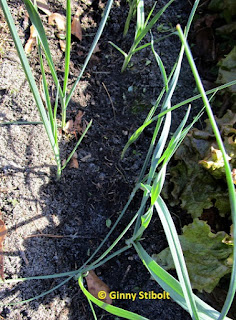 |
| Freshly harvested leeks have had most of their leaves chopped off above their fat stems. |
Leeks (Allium ampeloprasum) are native to the Mediterranean region and were developed as a crop in Europe and their mild taste makes them a favorite for soups. They form a thick stem at the base that continues fairly high into the plant. The flat, solid leaves are folded and grow on opposite sides of the stem, but no true bulb is formed. Because the leaves are flat, leeks are on the garlic side of this genus and indeed elephant garlic is a cultivar of this species (A. ampeloprasum var. ampeloprasum). The onion side of this genus has hollow leaves like chives.
In "Organic Methods for Vegetable Gardening in Florida," we classified them as easy to grow. But, they have a long growing season from early fall to early summer and they need a fair amount of attention during that time. The seedlings need to be replanted into a trench and have soil and/or mulch gradually added around them to induce the formation of thick, pale stems. They also need weeding and supplemental irrigation for good growth. So maybe "easy" is not a totally honest assessment.
Plant the seeds early in the fall and transplant them as eight-to-ten-inch seedlings into a ten-inch-deep trench in winter or early spring. As the plants grow, carefully fill in the trench with soil or mulch to create a mound around each plant, taking care to avoid getting soil into the folds of the leaves. The resulting grit is nearly impossible to remove and may end up in your soup. Covering the lower part of the plant keeps it white and sweet; it also encourages the stem to grow thicker.
You may harvest leeks at any time once the stem is one inch in diameter. I harvested the leeks near the end of June, but in retrospect I should have harvested them before the rainy season began because some of the outside leaves were beginning to get mushy. I was hoping they'd grow more in diameter, but no. The season was over.
 |
| The stem is dense with some layering like onions. When sliced thin like this, they can be added to salads or sauteed. |
We found a number of interesting ways to use the leeks. We started with the traditional method of preparation: potato-leek soup. I sliced them thinly and used the leeks raw in various salads. We made a leek-tomato quiche, which was yummy. They added an interesting garlicy note on pizza. I used them pureed as part of a pesto dressing. We have more in the refrigerator, so we'll continue to find ways to use them. We'll be cooking to the harvests, yet again.
 |
 |
| Our potato-leek soup was amazing. I added chopped chives and cherry tomatoes as garnish. | This crustless tomato-leek quiche was delicious. |
Would I grow them again in a normal year when we'd be traveling some of the time? Probably not. They take too much attention. But we have enjoyed the experience of having them this year.
I hope you are having fun trying new vegetables in your gardens.
Green Gardening Matters,
Ginny Stibolt





No comments:
Post a Comment